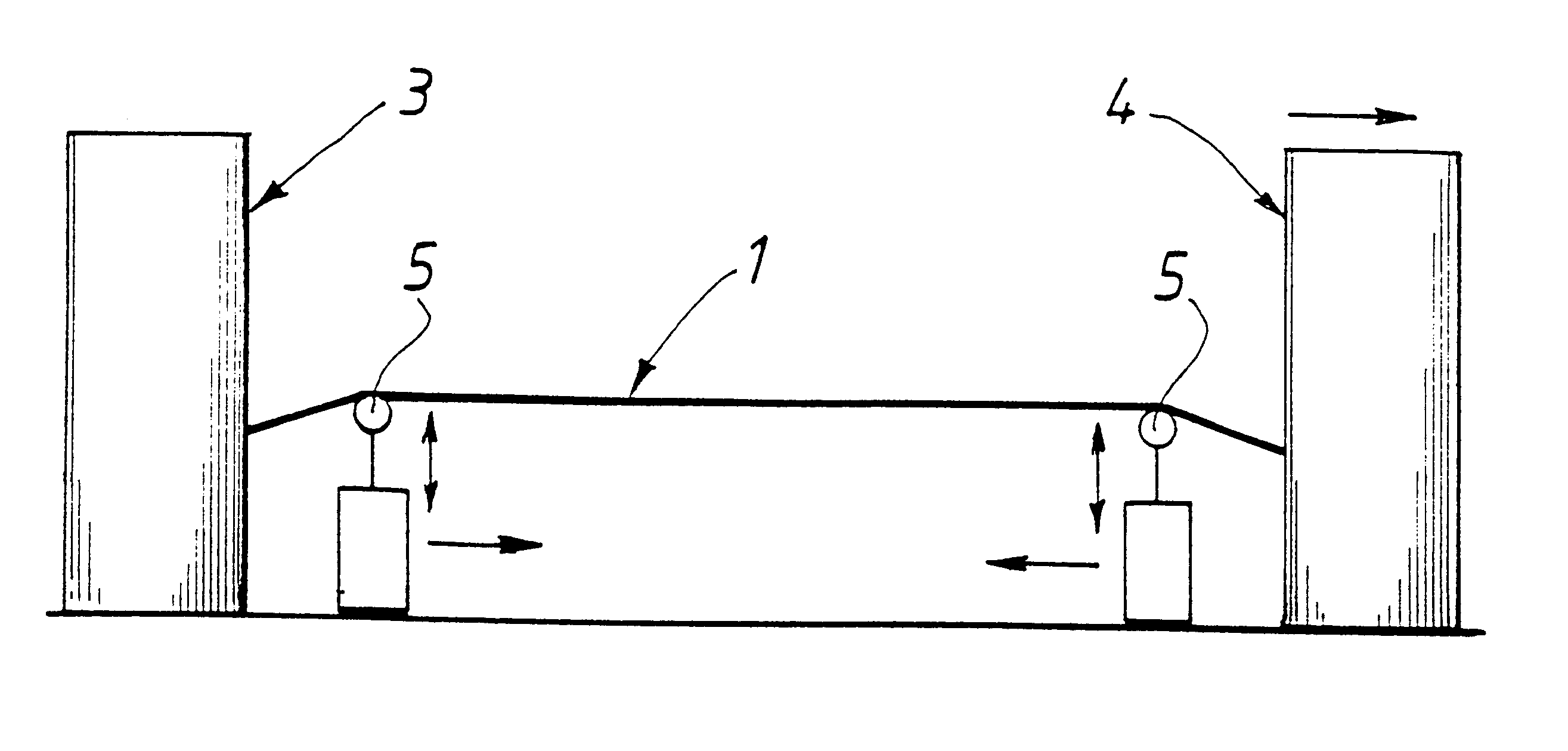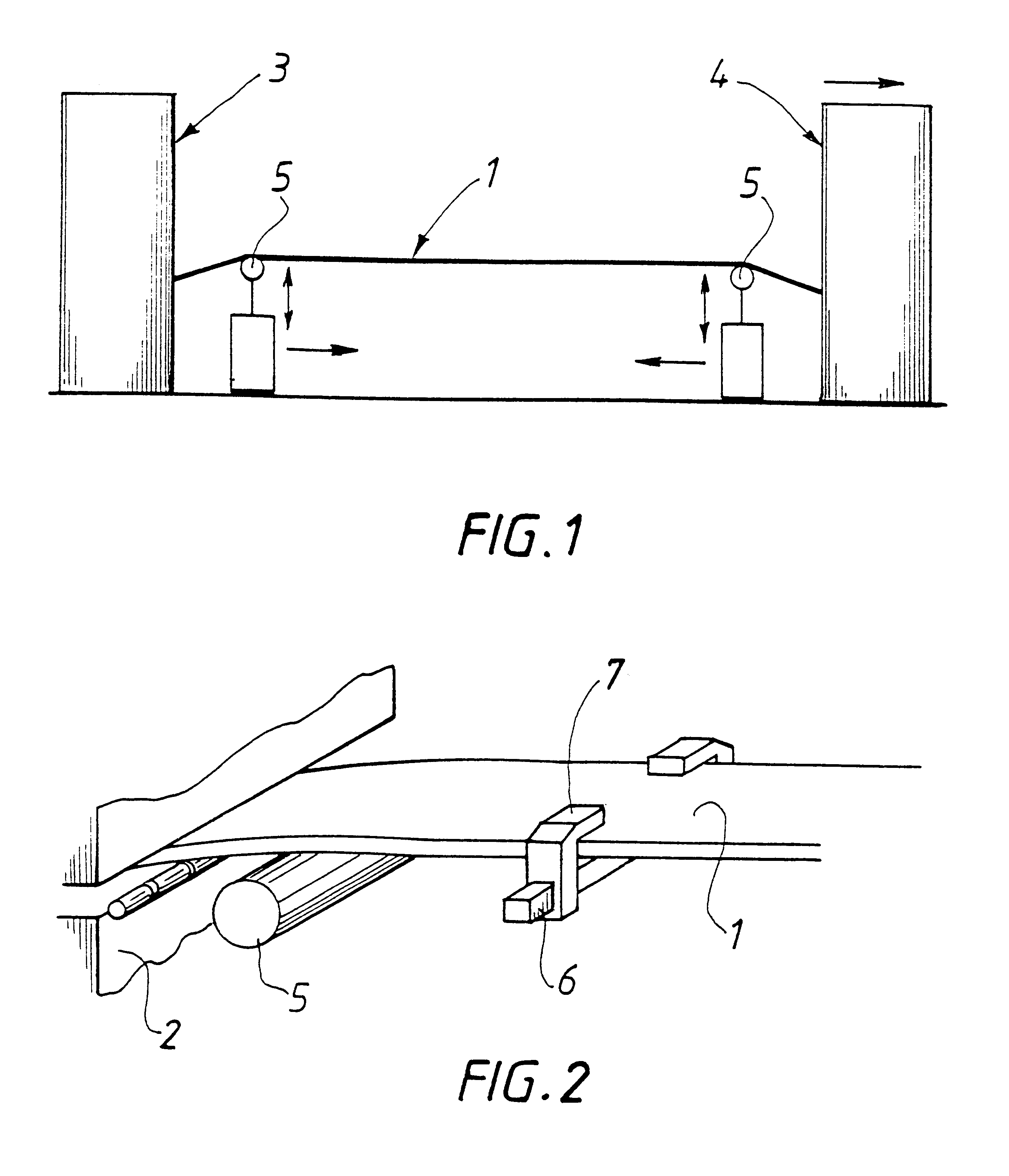Process for improving the planeness of a metal sheet
- Summary
- Abstract
- Description
- Claims
- Application Information
AI Technical Summary
Problems solved by technology
Method used
Image
Examples
example 1
A 7788.times.1896.times.25.4 mm sheet made of 6061 aluminum alloy (using the designation of The Aluminum Association) with a chemical composition (% by weight) of approximately Si=0.7, Fe=0.3, Cu=0.25, Mn=0.08, Mg=1.0, Cr=0.2, Zn=0.15 was made by semi-continuous casting of a sheet, homogenization, hot rolling and quenching by water spraying. A positive transverse bow (concave upwards) of between 14.5 and 29.5 mm was measured along the sheet. Simple stretching was then applied to the sheet according to prior art, with no additional anti-bow device added to produce an elongation of 2.1%, and a positive transverse bow (concave upwards) of between 1.8 and 11 mm was observed. This maximum value of 11 mm is outside the maximum tolerance allowed by standard EN 485-3 which is 0.4% of the width, or 7.6 mm.
example 2
Three 60.1.times.1290.times.8449 mm sheets made of 7075 alloy were made and quenched under the same conditions. Their camber measured over 2400 mm was of the order of 5 mm. Stretching was applied to the first sheet to produce a permanent elongation of 2.2%, without the addition of any other device. Stretching was applied to the second sheet to 2.1% with the addition of 2 anti-bow bars. Stretching was applied to the third sheet to 2.2%, and two fixed rolls were used in addition to the two anti-bow bars. The bow (in mm) was measured every meter along the length. The results are shown in table 1, the various values of t.sub.i corresponding to the 8 measurement points.
After stretching, the camber measured over a length of 2000 mm was 2 mm for the first and second sheets, and 1 mm for the third.
example 3
A sheet made of the same alloy and the same size as the sheet in example 1 had a positive transverse bow after quenching of between 4 and 24 mm for the part located between 0 and 6150 mm from one side, a W-shaped corrugation close to dimension 6150 mm and a negative transverse bow (concave downwards) of between 2.5 and 7 mm over the rest of the sheet.
Stretching was applied in four successive steps:
the first step to an elongation of 0.3% using two pressure rolls located at dimensions 1650 and 6150 mm respectively,
the second step to an elongation of 0.9%, after having moved the first roll from dimension 1650 mm to dimension 2975 mm,
a third step up to 1.6% elongation after having moved the first roll to dimension 4350 mm,
the fourth step up to 2% elongation without the rolls.
The measurement of the final planeness shows a positive transverse bow over the entire sheet of between 1 and 2.8 mm, with a very significant reduction in defects at locations at which the rolls were applied. The mo...
PUM
| Property | Measurement | Unit |
|---|---|---|
| Fraction | aaaaa | aaaaa |
| Pressure | aaaaa | aaaaa |
| Elongation | aaaaa | aaaaa |
Abstract
Description
Claims
Application Information
 Login to View More
Login to View More - R&D
- Intellectual Property
- Life Sciences
- Materials
- Tech Scout
- Unparalleled Data Quality
- Higher Quality Content
- 60% Fewer Hallucinations
Browse by: Latest US Patents, China's latest patents, Technical Efficacy Thesaurus, Application Domain, Technology Topic, Popular Technical Reports.
© 2025 PatSnap. All rights reserved.Legal|Privacy policy|Modern Slavery Act Transparency Statement|Sitemap|About US| Contact US: help@patsnap.com


